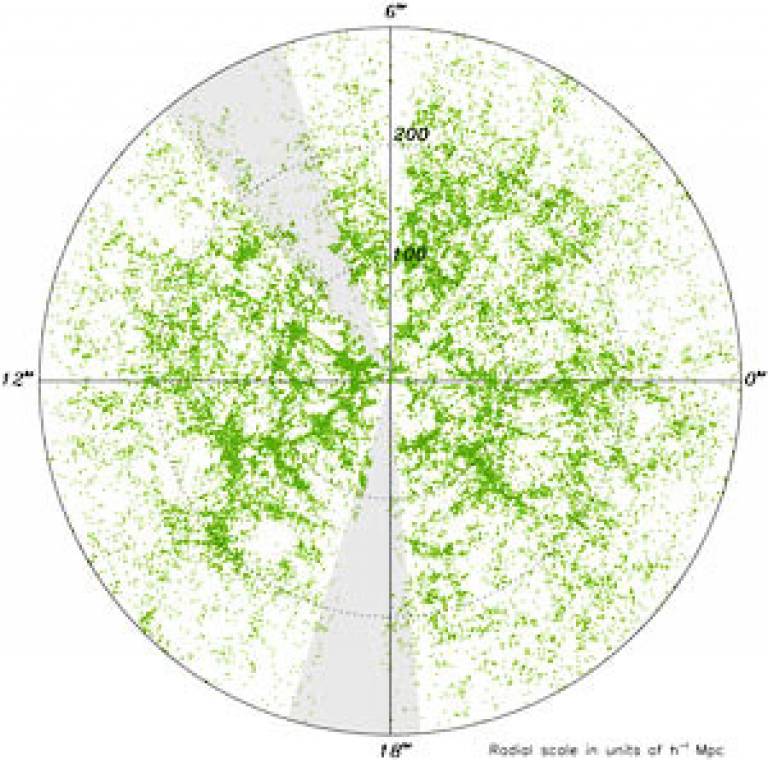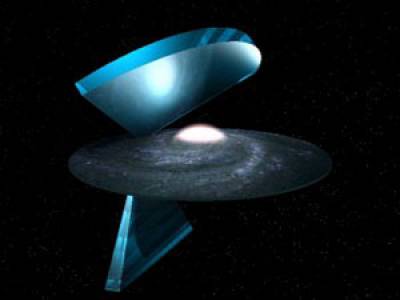The Dark Side of UCL
11 May 2005
In an unassuming corner of UCL's North Cloisters, a group of researchers is hard at work on an immense task - the creation of three-dimensional galaxy maps of millions of galaxies.

Professor Ofer Lahav, Head of UCL's Astrophysics Group, established the Cosmology Research Group last year with the appointment of two lecturers, Dr Sarah Bridle and Dr Jochen Weller. The group members are currently working on data from the Six Degree Field Galaxy Survey (6dFGS), an international project to measure and plot the nearby universe in three dimensions. Two PhD students, Ms Alexandra Abate and Ms Anais Rassat are busy analysing data from the new survey as well as from simulated data.
Professor Lahav and Ms Rassat recently visited the 6dF facility in Australia to discuss the on-going project with their Australian colleagues.
When complete, the survey will be the largest redshift survey of its kind, covering the entire southern sky. Another sample of the bright galaxies, selected in the near infrared covers the entire sky.
The project builds upon the Two Degree Field Galaxy Redshift Survey (2dFGRS), a study of 230,000 galaxies in two thin ribbons of sky, one in each of the north and south galactic caps covering 2,000 square degrees. Data is captured by the 2dF instrument at the Anglo-Australian Observatory, one of the world's most complex astronomical devices. The expansion of the universe shifts galaxy spectra to longer wavelengths to the red end of the spectrum. By measuring this redshift in a galaxy's spectrum, the galaxy's distance can be determined. Professor Lahav said: "What we have with 2dFGRS is a shell, which we can fill in with data from 6dFGS over a wider field of view."

The 2dF survey revealed how galaxies are scattered across the universe in huge clusters, long filaments and empty voids. Professor Lahav said: "The map is interesting for what it shows us, but also for what we cannot see. It confirms that the visible parts of the universe, such as stars and galaxies, only constitute a small fraction of its total mass. Imagine a Christmas tree in the dark with lights hung around it - we can see the lights, but not the tree, although it is the tree that constitutes the majority of total mass.
The latest cosmological data suggests that the universe is a
mysteriously dark place. It is probably made up of four entities, three
of them rather exotic; ordinary matter (four per cent), 'cold' dark matter
(approximately 26%) and dark energy (about 70%), suggested originally by
Einstein and possibly a small amount of massive neutrinos" Once the three-dimensional map of the southern sky has been
completed, Professor Lahav is looking to take UCL's Astrophysics group
to a new level - as world leaders in certain aspects of Dark Energy. He
said: "Our next project will be to participate in a Dark Energy Survey
with US collaborators, to discover the different components the universe
consists of. This new survey will map the distribution of 300 million
galaxies - a new record in surveying the universe".
Images: Top - A slice of the area measured by 6dFGS. Bottom - The ribbons of sky mapped in 2dFGRS.
To find out more about the Cosmology group or the surveys use the links below.
 Close
Close

